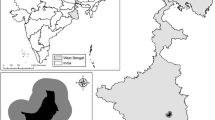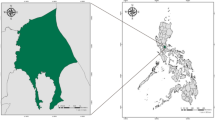Abstract
Representing and measuring the status of land use and land cover (LU and LC) alterations and drivers of alteration are essential for classifying susceptible regions for alteration and planning sustainable environmental services. This study presents the contributing factors of LU and LC and the extent and effects of these changes on sustainable LU in the Diyala River drainage area, north of Iraq. Five major LU and LC types (cultivated and settled land, bare land, water bodies, and palm) from Landsat images of 2013, 2016, 2019, and 2022 were mapped. The images were classified using a classification algorithm and a maximum likelihood classifier. The normalized difference vegetation index (NDVI), vegetation condition index (VCI), and land surface temperature (LST) maps are derived using multi-temporal Landsat 8 and 9 OLI/TIRS satellites. In the past decade, the buildup and barren lands have expanded from 1295.8 km2 (3.9%) to 1677.4 km2 (5.1%) and 5770.3 km2 (17.5%) to 8501.1 km2 (25.8%), whereas the vegetation cover has declined from 25,273.9 km2 (76.6%) to 22,421.8 km2 (68.0%). NDVI saw a significant rise in 2019 and 2022. There were maximum changes in NDVI in the northeast and southeast, where rainfall was higher than before in some parts. The VCI results showed that in 2022, there was a larger class area, with a prolonged extreme drought extent of 5727.1 km2 (47.8%). The findings imply that NDVI and LST are more closely correlated drought indices and are appropriate for use in arid and semi-arid areas to monitor drought with limited data. These studies will advance our knowledge of the connections between drought indices from remote sensing and meteorology. It is suggested that this research methodology be used again in the future, taking into account the impact of changes in climate that affect LU and LC patterns in similar climates.









Similar content being viewed by others
Data availability
The data obtainable in the current research are freely available from USGS at https://earthexplorer.usgs.gov/.
References
Al-Faraj FA, Scholz M (2015) Impact of upstream anthropogenic river regulation on downstream water availability in transboundary river watersheds. Int J Water Resour Dev 31(1):28–49
AL-Timimi YK, George LE, MH AL-J (2012) Drought risk assessment in Iraq using remote sensing and GIS techniques. Iraqi J Sci 53(4):1078–1082
Arsyad M, Tiwow VA, Rampe MJ (2018) Analysis of magnetic minerals of iron sand deposit in Sampulungan Beach, Takalar Regency, South Sulawesi using the x-ray diffraction method. In J Phys Conf Ser 1120(1):012060
Assaf AT, Sayl KN, Adham A (2021) Surface Water Detection Method for Water Resources Management. In J Phys Conf Ser 1973(1):–012149
Degife A, Worku H, Gizaw S, Legesse A (2019) Land use land cover dynamics, its drivers and environmental implications in Lake Hawassa Watershed of Ethiopia. Remote Sens Appl: Soc Environ 14:178–190. https://doi.org/10.1016/j.rsase.2019.03.005
Dibaba WT, Demissie TA, Miegel K (2020) Drivers and implications of land use/land cover dynamics in Finchaa catchment, northwestern Ethiopia. Land 9(4):113. https://doi.org/10.3390/land9040113
ESRI (2011) ArcGIS Desktop: Release 10. Environmental Systems Research Institute, Redlands
Gaznayee HA, Al-Quraishi AMF (2019) Analysis of agricultural drought’s severity and impacts in Erbil Province, the Iraqi Kurdistan region based on time series NDVI and TCI indices for 1998 through 2017. J Dyn Control Syst 11(11):287–297
Gaznayee HAA, Al-Quraishi AMF, Al-Sulttani AHA (2021) Drought Spatiotemporal Characteristics Based on a Vegetation Condition Index in Erbil, Kurdistan Region, Iraq. Iraqi J Sci:4545–4556. https://doi.org/10.24996/ijs.2021.62.11(SI).34
Gaznayee HAA, Al-Quraishi AMF, Mahdi K, Ritsema C (2022) A Geospatial Approach for Analysis of Drought Impacts on Vegetation Cover and Land Surface Temperature in the Kurdistan Region of Iraq. Water 14(6):927
Goward SN, Xue Y, Czajkowski KP (2002) Evaluating land surface moisture conditions from the remotely sensed temperature/vegetation index measurements: An exploration with the simplified simple biosphere model. Remote Sens Environ 79(2-3):225–242
Hailu Y, Tilahun B, Kerebeh H, Tafese T (2018) Land use land cover change detection in Gibe Sheleko National Park, Southwestern Ethiopia. J Agric Resour Econ 4(1868–2019–381):20–30. https://doi.org/10.22004/ag.econ.281757
Hussain S, Karuppannan S (2023) Land use/land cover changes and their impact on land surface temperature using remote sensing technique in district Khanewal, Punjab Pakistan. Geol Ecol Landsc 7(1):46–58. https://doi.org/10.1080/24749508.2021.1923272
Hussain S, Mubeen M, Ahmad A, Akram W, Hammad HM, Ali M, Masood N, Amin A, Farid HU, Sultana SR, Fahad S, Wang D, Nasim W (2020a) Using GIS tools to detect the land use/land cover changes during forty years in Lodhran District of Pakistan. Environ Sci Pollut Res 27:39676–39692. https://doi.org/10.1007/s11356-019-06072-3
Hussain S, Mubeen M, Akram W, Ahmad A, Habib-ur-Rahman M, Ghaffar A, Amin A, Awais M, Farid HU, Farooq A, Nasim W (2020b) Study of land cover/land use changes using RS and GIS: a case study of Multan district, Pakistan. Environ Monit Assess 192(1):1–15
Hussain S, Mubeen M, Karuppannan S (2022) Land use and land cover (LULC) change analysis using TM, ETM+ and OLI Landsat images in district of Okara, Punjab, Pakistan. Phys Chem Earth A/B/C 126:103117. https://doi.org/10.1016/j.pce.2022.103117
Julien Y, Sobrino JA (2010) Comparison of cloud-reconstruction methods for time series of composite NDVI data. Remote Sens Environ 114(3):618–625
Juliev M, Pulatov A, Fuchs S, Hübl J (2019) Analysis of Land Use Land Cover Change Detection of Bostanlik District, Uzbekistan. Pol. J Environ Stud 28(5). https://doi.org/10.15244/pjoes/94216
Khwarahm NR, Najmaddin PM, Ararat K, Qader S (2021a) Past and future prediction of land cover land use change based on earth observation data by the CA–Markov model: a case study from Duhok governorate, Iraq. Arab J Geosci 14(15):1–14
Khwarahm NR, Qader S, Ararat K, Al-Quraishi AMF (2021b) Predicting and mapping land cover/land use changes in Erbil/Iraq using CA-Markov synergy model. Earth Sci Inform 14(1):393–406. https://doi.org/10.1007/s12145-020-00541-x
Lin X, Xu M, Cao C, Singh PR, Chen W, Ju H (2018) Land-use/land-cover changes and their influence on the ecosystem in Chengdu City, China during the period of 1992–2018. Sustainability 10(10):3580. https://doi.org/10.3390/su10103580
Mahdi ZA, Mohammed R (2022) Land use/land cover changing aspect implications: Lesser Zab River Basin, northeastern Iraq. Environ Monit Assess 194(652):1–16. https://doi.org/10.1007/s10661-022-10324-0
Mohammed J (2013) Land use and cover change assessment using Remote Sensing and GIS: Dohuk City, Kurdistan, Iraq (1998–2011). Int J Geomat Geosci 3(3):552
Mohammed OA, Sayl KN (2020) Determination of Groundwater potential zone in arid and semi-arid regions: A review. In: In 2020 13th International Conference on Developments in eSystems Engineering (DeSE). IEEE, pp 76–81
Mohammed OA, Sayl KN (2021) A GIS-based multicriteria decision for groundwater potential zone in the west desert of Iraq. IOP Conf Ser: Earth Environ Sci 856(1):012049
Mohammed R, Scholz M (2018) Climate change and anthropogenic intervention impact on the hydrologic anomalies in a semi-arid area: Lesser Zab River Catchment, Iraq. Environ Earth Sci 77(10):1–19. https://doi.org/10.1007/s12665-018-7537-9
Mohammed SS, Sayl KN, Kamel AH (2022) Ground water recharge mapping in Iraqi Western Desert. Int J Des Nat Ecodyn 17(6):913–920. https://doi.org/10.18280/ijdne.170612
Mohy HAA, Rasheed KG (2022) Morphological perspective of urban resilience through eco urban landscape: Iraq -Basra as a case study. Int J Des Nat Ecodyn 17(6):807–821. https://doi.org/10.18280/ijdne.170601
Muneer AS, Sayl KN, Kamal AH (2021) Modeling of spatially distributed infiltration in the Iraqi Western Desert. Appl Geomat 13:467–479
Mustafa Y (2020) Spatiotemporal analysis of vegetation cover in Kurdistan region-Iraq using MODIS image data. J Appl Sci Technol Trends 1(1):01–07
Mustafa YT, Ismail DR (2019) Land use land cover change in Zakho District, Kurdistan Region, Iraq: past, current and future. In: In 2019 International Conference on Advanced Science and Engineering (ICOASE). IEEE, pp 141–146
Naqi NM, Al-Jiboori MH, Al-Madhhachi AST (2021) Statistical analysis of extreme weather events in the Diyala River basin, Iraq. J Water Clim Chang 12(8):3770–3785
Naqi NM, Al-Madhhachi AST, Al-Jiboori MH (2022) Quantifying Diyala River basin rainfall-runoff models for normal and extreme weather events. Water Pract Technol 17(8):1553–1569
Saleh AM, Ahmed FW (2021) Analyzing Land Use/Land Cover Change Using Remote Sensing and GIS in Mosul District, Iraq. Ann Romanian Soc Cell Biol:4342–4359
Sameer YM, Abed AN, Sayl KN (2021) Highway route selection using GIS and analytical hierarchy process case study Ramadi Heet rural highway. J Phys Conf Ser 1973(1):012060
Sameer YM, Abed AN, Sayl KN (2023) Geomatics-based approach for highway route selection. Appl Geomat 15(1):161–176
Sayl KN, Sulaiman SO, Kamel AH, Al-Ansari N (2022) Towards the Generation of a Spatial Hydrological Soil Group Map Based on the Radial Basis Network Model and Spectral Reflectance Band Recognition. Int J Des Nat Ecodyn 17(5):761–766
Sun Q, Tan J, Xu Y (2010) An ERDAS image processing method for retrieving LST and describing urban heat evolution: a case study in the Pearl River Delta Region in South China. Environ Earth Sci 59(5):1047–1055
Talib R, Shamkhi MS (2022) Impact of Climate Change on Integrated Management of Water Resources in The lower Basin of Diyala River, Iraq. Wasit J Eng Sci 10(3):145–160
Tayyeh HK, Mohammed R (2023) Analysis of NASA POWER Reanalysis Products to Predict Temperature and Precipitation in Euphrates River Basin. J Hydrol 619:129327
Viera AJ, Garrett JM (2005) Understanding inter observer agreement: the kappa statistic. Fam Med 37(5):360–363
Yesuph AY, Dagnew AB (2019) Land use/cover spatiotemporal dynamics, driving forces and implications at the Beshillo catchment of the Blue Nile Basin, North Eastern Highlands of Ethiopia. Environ Syst Res 8(21):1–30. https://doi.org/10.1186/s40068-019-0148-y
Acknowledgements
The authors admit the aid of their respective institutions. This research did not receive any particular assistance from funding agents in the public, private, or not-for-profit sectors
Author information
Authors and Affiliations
Contributions
Mohammed made a commitment to gather and analyse data, and Ruqayah Mohammed presented the key study idea and methodology, discussed the got outcomes, and wrote and reviewed the manuscript.
Corresponding author
Ethics declarations
Competing interests
Not applicable
Additional information
Publisher’s note
Springer Nature remains neutral with regard to jurisdictional claims in published maps and institutional affiliations.
Mohammed H. Younus is an MsC student.
Rights and permissions
Springer Nature or its licensor (e.g. a society or other partner) holds exclusive rights to this article under a publishing agreement with the author(s) or other rightsholder(s); author self-archiving of the accepted manuscript version of this article is solely governed by the terms of such publishing agreement and applicable law.
About this article
Cite this article
Younus, M.H., Mohammed, R. Geo-informatics techniques for detecting changes in land use and land cover in response to regional weather variation. Theor Appl Climatol 154, 89–106 (2023). https://doi.org/10.1007/s00704-023-04536-8
Received:
Accepted:
Published:
Issue Date:
DOI: https://doi.org/10.1007/s00704-023-04536-8




